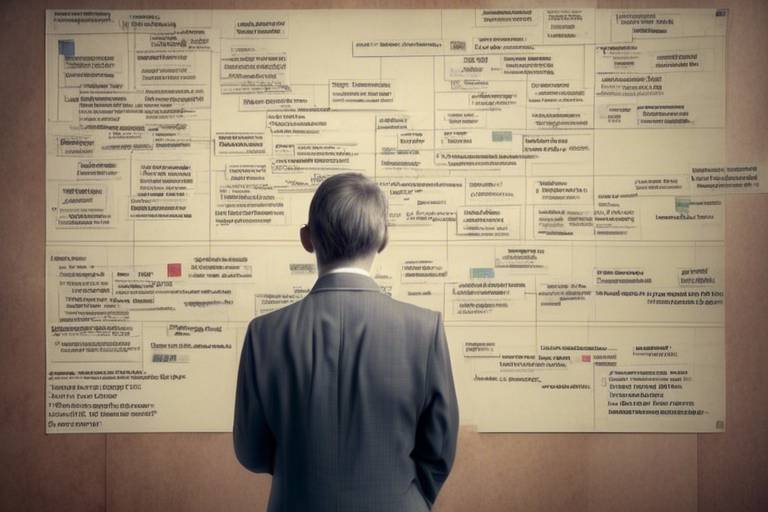How to Develop Comprehensive Literature Reviews
Creating a comprehensive literature review is akin to piecing together a jigsaw puzzle, where each piece represents a different study, theory, or perspective. The goal? To form a complete picture of the existing knowledge on a given topic. In the academic world, literature reviews are not just a box to tick off; they are a foundational element that can significantly enhance the quality of your research. This article provides a detailed guide on how to craft these reviews effectively, ensuring that you can contextualize your research, identify gaps in the existing literature, and ultimately contribute meaningfully to your field.
At its core, a literature review serves several key purposes. First and foremost, it contextualizes your research within the broader academic landscape. Imagine you’re trying to build a house; you wouldn’t start without understanding the land, right? Similarly, a literature review helps you identify gaps in existing research, frame your research questions, and demonstrate your scholarly engagement with the topic. By synthesizing previous studies, you can show how your work builds upon or diverges from what has already been established.
When it comes to literature reviews, not all sources are created equal. Selecting credible and relevant sources is crucial for ensuring that your review is robust and trustworthy. As you embark on this journey, consider these criteria for source selection:
- Peer-reviewed articles: These are the gold standard in academic research, as they have undergone rigorous evaluation by experts in the field.
- Books: Look for scholarly books that provide in-depth analysis and comprehensive coverage of your topic.
- Reputable databases: Utilize academic databases like JSTOR, PubMed, or Google Scholar to find reliable sources.
By focusing on high-quality sources, you ensure that your literature review is not only informative but also credible.
A well-defined research question is the compass that guides your literature review process. Without it, you might find yourself wandering aimlessly through a sea of information. To formulate effective questions, consider the following techniques:
- Identify gaps in the existing literature.
- Align your question with the objectives of your review.
- Ensure that your question is specific and researchable.
By honing in on a clear research question, you can streamline your literature review and focus your analysis on the most pertinent studies.
Structuring your literature review logically is essential for enhancing readability and comprehension. A well-organized review allows readers to follow your thought process and understand how various studies interconnect. You might consider various organizational frameworks, such as:
- Chronological: Presenting sources in the order they were published can highlight the evolution of research over time.
- Thematic: Grouping studies by theme or topic can help clarify how different pieces of research contribute to a particular aspect of your review.
- Methodological: Organizing by research methods used can provide insight into the approaches taken within the field.
Choosing the right structure will depend on your research question and the nature of the literature you are reviewing.
Summarizing findings from multiple sources is crucial for clarity and coherence. As you synthesize information, aim to maintain the original context and significance of each study. One effective strategy is to create a comparison table:
| Study | Key Findings | Relevance to Your Research |
|---|---|---|
| Study A | Found that X leads to Y. | Supports the hypothesis that Z is true. |
| Study B | Showed a correlation between A and B. | Contradicts previous findings, suggesting a need for further investigation. |
This table format can help you visualize how different studies relate to each other and to your own research, making it easier to draw connections.
Critically analyzing your sources adds depth to your literature review. It’s not enough to simply summarize what each study found; you need to evaluate the strengths and weaknesses of each source. Consider questions like:
- What are the limitations of this study?
- How does this research compare to others in the field?
- What biases might affect the findings?
By fostering a balanced perspective, you can present a nuanced view of the literature that acknowledges various viewpoints and limitations.
Effective writing techniques can elevate the quality of your literature review. Aim for clarity and coherence, using an academic tone that engages your readers. Here are some tips:
- Use clear and concise language.
- Maintain a logical flow between paragraphs.
- Incorporate transitional phrases to guide readers through your arguments.
Remember, your goal is to make complex information accessible and engaging.
Proper citation is vital for academic integrity. It not only gives credit to original authors but also allows readers to trace your research. Familiarize yourself with different citation styles, such as APA, MLA, or Chicago, and adhere to best practices for referencing sources in your literature review.
Q: What is the main purpose of a literature review?
A: The primary purpose is to contextualize your research within existing knowledge, identify gaps, and frame research questions.
Q: How do I choose the right sources for my literature review?
A: Focus on peer-reviewed articles, scholarly books, and reputable databases to ensure credibility.
Q: What should I include in my literature review?
A: Include summaries of key findings, critical analyses of sources, and a clear organizational structure.
Q: How do I ensure my literature review is well-written?
A: Use clear language, maintain coherence, and follow academic writing conventions.

Understanding the Purpose of Literature Reviews
Literature reviews are not just a formality in academic writing; they serve as the backbone of any research endeavor. Think of a literature review as a treasure map that guides you through the vast landscape of existing knowledge. By contextualizing your research within this landscape, you can identify what has been done and where your work fits in. This process is crucial for several reasons:
Firstly, literature reviews help in identifying gaps in the current research. Imagine walking into a library filled with books; some topics are well-covered, while others are barely touched. A literature review allows you to pinpoint these under-explored areas, enabling you to formulate research questions that can contribute something new and valuable to your field.
Secondly, these reviews frame your research questions. By understanding the existing body of work, you can craft questions that are not only relevant but also intriguing. It's like setting up a chess game; you need to know the pieces already on the board before you can make your next move.
Moreover, literature reviews demonstrate your scholarly engagement. They show that you are not just a passive observer in your field but an active participant who understands the nuances of ongoing debates and discussions. This engagement is vital for establishing credibility among your peers and mentors.
To summarize, the purposes of literature reviews can be encapsulated in the following key points:
- Contextualization: Positioning your research within the existing body of knowledge.
- Gap Identification: Highlighting areas that require further exploration.
- Research Question Framing: Crafting relevant and impactful research questions.
- Scholarly Engagement: Demonstrating your involvement and understanding of the field.
Understanding these purposes is essential for anyone looking to produce a high-quality literature review. It sets the stage for the entire research process, ensuring that your work is not only relevant but also impactful. So, as you embark on your literature review journey, keep these objectives in mind—they will serve as your guiding principles.

Choosing the Right Sources
When it comes to crafting a comprehensive literature review, one of the most critical steps is . Imagine trying to build a house without a solid foundation; your literature review is no different. The sources you select will not only shape your arguments but also influence the credibility of your research. So, how do you sift through the vast sea of information available and find those golden nuggets that will truly enhance your review?
First and foremost, you want to focus on credibility. This means prioritizing peer-reviewed articles, scholarly books, and reputable databases. Peer-reviewed articles are like the gold standard of academic writing. They undergo rigorous scrutiny by experts in the field before publication, ensuring that the information is both reliable and valid. On the other hand, books can provide extensive background and detailed discussions on a topic, but it’s essential to check their publication date to ensure the information is still relevant.
Next, consider the relevance of the sources to your specific research question. Not every article will be a perfect fit, and that’s okay! You should look for sources that directly address your topic or contribute to the understanding of your research question. A good rule of thumb is to ask yourself: Does this source provide valuable insights or data that will help me answer my research question? If the answer is no, it’s time to move on.
Additionally, keep an eye out for diversity in perspectives. A well-rounded literature review should include a variety of viewpoints. This not only enriches your analysis but also demonstrates your engagement with the scholarly community. For instance, if you're researching a controversial topic, seek out sources that represent different sides of the argument. This will allow you to present a balanced view and critically engage with the material.
Another aspect to consider is the publication date. In fast-evolving fields, such as technology or medicine, recent studies may hold more weight than older ones. However, don’t dismiss older sources outright; they can provide foundational knowledge or historical context that is invaluable. A good strategy is to create a mix of both recent and seminal works in your literature review.
To help you visualize the selection process, here’s a simple table outlining the criteria for choosing sources:
| Criteria | Explanation |
|---|---|
| Credibility | Look for peer-reviewed articles and academic publications. |
| Relevance | Ensure the source directly relates to your research question. |
| Diversity | Include multiple perspectives to provide a balanced view. |
| Publication Date | Consider the timeliness of the information, particularly in fast-paced fields. |
Lastly, don’t forget to utilize library databases and online academic resources. Platforms like JSTOR, Google Scholar, or your institution's library can be treasure troves of quality literature. They often provide access to a wide range of journals and publications that might not be available elsewhere. By tapping into these resources, you can ensure that your literature review is not only comprehensive but also rich in quality content.
In conclusion, choosing the right sources for your literature review is an art that requires careful consideration and a strategic approach. By focusing on credibility, relevance, diversity, and publication date, you can build a strong foundation for your research that will stand the test of time. Remember, the quality of your literature review hinges on the sources you choose, so take the time to select wisely!
- What types of sources should I prioritize? Peer-reviewed articles and academic books are essential for credibility.
- How many sources should I include? It varies by topic, but aim for a diverse selection that adequately covers your research question.
- Can I use non-academic sources? While academic sources are preferred, reputable non-academic sources can be used if they provide valuable insights.

Developing a Research Question
When it comes to crafting a literature review, the first step is to develop a research question that will serve as your guiding star. Think of it as the compass that points you in the right direction amidst the vast ocean of existing literature. A well-defined research question not only clarifies your focus but also helps you to navigate through the sea of information, ensuring that your literature review remains relevant and targeted.
So, how do you go about formulating an effective research question? First, it’s essential to understand the core objectives of your literature review. Are you aiming to identify gaps in existing research? Or perhaps you want to explore a specific phenomenon in depth? Whatever your aim, your research question should align closely with these objectives. To illustrate this, let’s break down a few techniques that can help you formulate a compelling research question:
- Start Broad, Then Narrow Down: Begin with a broad topic that interests you. For example, if you're fascinated by climate change, you might start with a question like, "What are the impacts of climate change on agriculture?" From there, you can narrow it down to something more specific, such as, "How does climate change affect wheat production in North America?"
- Consider the 'So What?' Factor: Ask yourself why your research question matters. What is its significance? This helps to ensure that your question is not only interesting but also meaningful in the context of existing research.
- Make It Researchable: Ensure that your question can be answered through the literature. A question like, "What are the effects of social media on mental health?" is broad, but it can be refined to something more specific, such as, "How does Instagram usage correlate with anxiety levels among teenagers?"
Once you have a draft of your research question, it’s crucial to test its feasibility. This means checking whether there are enough existing studies to provide a foundation for your literature review. If your question is too niche, you might struggle to find relevant sources. Conversely, if it’s too broad, you might find yourself overwhelmed with information. Striking a balance is key!
Another important aspect to consider is the language of your research question. It should be clear, concise, and free of jargon. Remember, the goal is to communicate your inquiry effectively, not to confuse your readers. A well-phrased question can set the tone for your entire literature review, inviting readers to engage with your work.
In conclusion, developing a strong research question is a vital step in the literature review process. It acts as the backbone of your research, guiding your exploration and helping you to synthesize findings effectively. So take your time, reflect on your objectives, and don’t hesitate to revise your question as you delve deeper into the literature. After all, a great research question can lead to insightful discoveries and a compelling literature review!
Q1: How specific should my research question be?
A: It should be specific enough to guide your literature review but broad enough to allow for comprehensive research. Aim for a balance that enables depth without being too limiting.
Q2: Can I change my research question after starting my literature review?
A: Absolutely! It’s common to refine or adjust your research question as you gather more information and insights from your sources.
Q3: What if I can’t find enough sources for my research question?
A: If you find yourself struggling, consider broadening your question or exploring related topics. This can help you uncover more relevant literature.

Organizing the Literature Review
When it comes to crafting a literature review, organization is key. Think of it as building a house; without a solid framework, everything can crumble. A well-structured literature review not only enhances readability but also guides the reader through your thought process. So, how do you create this framework? There are several organizational frameworks you can choose from, each with its own benefits and nuances.
One popular method is the chronological approach. This framework allows you to present the literature in the order it was published, highlighting how the field has evolved over time. It’s like telling a story where each chapter builds upon the last. For instance, if you’re reviewing studies on climate change, you could start with early research from the 1970s and gradually move to contemporary studies, showcasing the progression of theories and findings.
Another effective method is the thematic approach. Here, you group the literature based on common themes or topics. This can be particularly useful when the body of work is vast and diverse. For example, if your literature review focuses on educational techniques, you might categorize the studies into themes such as technology in the classroom, student engagement, and assessment strategies. This not only makes your review more digestible but also allows you to draw connections between different studies that might not be immediately apparent.
Then, there’s the methodological approach, which organizes the literature based on the research methods employed in the studies. This can be particularly useful in fields where different methodologies yield different insights. For instance, if you’re examining the effects of a new teaching method, you could categorize the literature into qualitative studies, quantitative studies, and mixed-methods studies. This framework helps highlight the strengths and weaknesses of various approaches and can provide a richer understanding of the topic.
Choosing the right organizational method depends on your specific research question and the volume of literature available. Consider what will make your review most coherent and impactful. You might even find that a combination of these methods works best for your particular project. For example, you could start with a chronological overview, then dive into thematic sections that explore specific aspects of the literature in greater depth.
As you organize your literature review, remember to maintain a logical flow. Use clear transitions between sections to guide your readers smoothly from one idea to the next. This is crucial for keeping your audience engaged and ensuring that they can follow your argumentation without getting lost in the details.
In conclusion, a well-organized literature review is like a well-tuned orchestra, where each section plays its part harmoniously. Whether you choose chronological, thematic, or methodological organization, make sure it aligns with your research objectives and helps illuminate the gaps in the existing literature. After all, the ultimate goal is to provide a comprehensive overview that not only informs but also inspires further research.
- What is the best way to organize a literature review? The best way depends on your research question; common methods include chronological, thematic, and methodological approaches.
- How long should a literature review be? The length varies based on the scope of your research, but it should be comprehensive enough to cover relevant literature thoroughly.
- Can I mix different organizational methods? Absolutely! A combination can often provide a clearer picture of the literature.
- What should I avoid when organizing my literature review? Avoid being too rigid; flexibility can help you adapt your structure as you delve deeper into the literature.

Summarizing Key Findings
When it comes to literature reviews, summarizing key findings is not just a box to check off; it’s a critical step that can make or break the quality of your work. Imagine you’re piecing together a puzzle—each piece represents a study or source you’ve reviewed. The final picture, or the comprehensive understanding of your topic, emerges only when you skillfully connect these pieces. Thus, summarizing findings effectively is essential for clarity and coherence.
To start, it’s important to extract the **main ideas** from each source. This doesn’t mean copying and pasting; rather, you should distill the essence of each study. What were the authors trying to convey? What were their conclusions? By answering these questions, you’ll not only grasp the core messages but also prepare to synthesize them later. Consider creating a table to organize these findings, which can serve as a handy reference as you write your review. Here’s a simple example:
| Source | Key Findings | Implications |
|---|---|---|
| Author A (2021) | Identified significant correlations between X and Y. | Impacts future studies on Z. |
| Author B (2020) | Proposed a new methodology for measuring A. | Challenges existing approaches. |
Once you’ve compiled your findings, the next step is to **synthesize** this information. Synthesis is the art of combining insights from various sources to create a cohesive narrative. Think of it as blending different flavors to create a delicious dish; each ingredient adds its unique taste, but together they form something greater. You can achieve synthesis by identifying patterns or themes that emerge across the studies. For instance, do multiple sources agree on a particular outcome? Are there conflicting viewpoints? Highlighting these connections not only enriches your review but also demonstrates your critical engagement with the literature.
Moreover, while summarizing, it’s crucial to maintain the **original context** and significance of each finding. This means being careful not to oversimplify complex ideas or misrepresent the authors’ intentions. A good practice is to include brief quotations or paraphrases from the original texts to support your summaries. This adds credibility and allows readers to see the nuances of the research.
Finally, remember that the goal of summarizing key findings is not just to inform but to **engage your readers**. Use clear and concise language, and avoid jargon unless absolutely necessary. The more accessible your writing, the more likely it is that your audience will appreciate and understand your insights. As you wrap up this section, aim to present a compelling narrative that not only summarizes the literature but also sets the stage for the critical analysis to follow. This will ensure that your literature review is not just a collection of summaries but a well-rounded exploration of your research topic.
- What is the main purpose of summarizing key findings in a literature review?
Summarizing key findings helps to clarify and synthesize the existing research, making it easier for readers to grasp the main contributions and gaps in the literature. - How can I effectively synthesize information from multiple sources?
Look for common themes, patterns, or contradictions in the findings, and weave them together in a narrative that highlights the relationships between the studies. - Should I include direct quotes from the sources?
Yes, including direct quotes can enhance the credibility of your summaries, but use them sparingly and ensure they add value to your analysis.

Critical Analysis of Sources
When diving into the depths of a literature review, one of the most crucial elements is the . This isn't just about summarizing what others have said; it's about dissecting their arguments, evaluating their methodologies, and understanding their implications. Think of it like being a detective in a mystery novel—each source is a clue that can lead you to a deeper understanding of your topic. By critically analyzing sources, you not only enrich your own understanding but also provide a more nuanced perspective for your readers.
To begin with, you should consider the credibility of each source. Is it published in a peer-reviewed journal? Does the author have relevant expertise? These questions help establish a foundation of trustworthiness. For instance, a study conducted by a renowned expert in the field carries more weight than an opinion piece in a local newspaper. You might want to create a simple table to compare the credibility of various sources:
| Source | Type | Peer-Reviewed? | Author's Credentials |
|---|---|---|---|
| Journal of XYZ | Journal Article | Yes | Dr. Jane Smith, PhD in Psychology |
| Local News Outlet | News Article | No | John Doe, Freelance Writer |
| ABC University Press | Book | Yes | Prof. Mark Johnson, Author of "Understanding Behavior" |
Next, you should analyze the methodologies employed in the studies you are reviewing. Are they robust and well-designed, or do they have glaring flaws? For example, a study with a small sample size may not provide reliable results, while one with a diverse and large sample could offer more generalizable findings. This critical lens allows you to identify gaps in the research, which can inform your own study or literature review.
Additionally, consider the context in which the research was conducted. What were the prevailing theories at the time? Were there any biases that might have influenced the results? Understanding these factors can help you appreciate the significance of the findings and how they fit into the larger academic conversation. It’s like piecing together a puzzle—each source adds a unique shape that contributes to the overall picture.
Moreover, don't shy away from discussing the implications of the findings. What do they mean for your research question? How do they challenge or support existing theories? This is where your own voice comes into play. By articulating your thoughts on the implications, you engage your readers and invite them to think critically alongside you. Remember, your literature review should not only present information but also provoke thought and discussion.
In conclusion, the critical analysis of sources is a vital skill that enhances the quality of your literature review. By assessing credibility, scrutinizing methodologies, understanding context, and discussing implications, you elevate your academic writing to a new level. It's not just about gathering information; it's about transforming that information into a meaningful narrative that resonates with your audience.
- What is the purpose of critically analyzing sources? Critical analysis helps to evaluate the reliability and relevance of sources, ensuring a well-rounded literature review.
- How do I determine if a source is credible? Look for peer-reviewed articles, check the author's qualifications, and consider the publication's reputation.
- Can I include non-peer-reviewed sources in my literature review? Yes, but be cautious and ensure they contribute valuable insights or context.
- What are some common mistakes in source analysis? Common mistakes include overlooking biases, failing to assess methodology, and not considering the source's context.

Writing the Literature Review
Writing a literature review can feel like navigating a labyrinth. You have a wealth of information at your fingertips, yet organizing it into a coherent narrative can be daunting. The key is to focus on clarity, coherence, and a suitable academic tone. Let’s break this down step by step to ensure your literature review not only informs but also engages your readers.
First and foremost, it’s essential to establish a clear thesis statement or purpose for your literature review. This statement acts as a compass, guiding your writing and keeping you on track. Ask yourself: What is the main argument or point I want to convey? Once you have this in mind, you can structure your review around it, ensuring that each section contributes to your overarching goal.
Next, consider the flow of your writing. A well-structured literature review should transition smoothly from one idea to the next. You can achieve this by using transitional phrases that connect your thoughts. For example, phrases like "Building on this idea..." or "In contrast to..." can help maintain the reader’s interest and clarify the relationships between different sources.
As you write, remember that summarizing key findings is crucial. You want to distill the essence of each source without losing its significance. A good technique is to create a summary table that captures the main points of each source. This can serve as a reference for both you and your readers, making it easier to compare and contrast different studies. Here’s a simple example:
| Source | Main Findings | Relevance |
|---|---|---|
| Smith et al. (2020) | Found a significant correlation between X and Y. | Supports the hypothesis of the review. |
| Johnson (2019) | Identified gaps in the existing literature. | Highlights the need for further research. |
However, it’s not just about summarizing; you also need to engage in critical analysis. This means evaluating the strengths and weaknesses of the sources you include. Are the methodologies sound? Do the conclusions logically follow from the data presented? By critically assessing each source, you not only provide a balanced perspective but also demonstrate your scholarly engagement with the material.
When it comes to writing style, aim for an academic tone that is still accessible. Avoid jargon and overly complex sentences that could alienate your readers. Instead, strive for a conversational yet professional voice. It’s like having a chat with a knowledgeable friend—informative but not intimidating.
Finally, don’t underestimate the power of revisions. After completing your first draft, take a step back, and let it sit for a day or two. When you return, read through it with fresh eyes, looking for areas that could be improved. Seek feedback from peers or mentors, as they can provide invaluable insights that you might have overlooked.
In conclusion, writing a literature review is not just about summarizing existing research; it’s about weaving a narrative that contributes to the academic conversation. By focusing on clarity, coherence, and critical analysis, you can create a literature review that stands out and offers real value to your readers.
- What is the purpose of a literature review? A literature review synthesizes existing research on a topic, identifies gaps, and provides a foundation for new research.
- How long should a literature review be? The length can vary, but it should be comprehensive enough to cover the relevant literature without being overly lengthy; typically, 10-20 pages is common.
- How do I choose sources for my literature review? Look for peer-reviewed articles, reputable books, and credible databases that are relevant to your research question.
- What citation style should I use? The citation style depends on your academic discipline; common styles include APA, MLA, and Chicago.
- Can I include my opinions in a literature review? While personal opinions should be minimal, you can offer critical analysis of the sources to provide a balanced perspective.

Citing Sources Properly
Citing sources properly is not just a matter of academic etiquette; it's a crucial component of scholarly writing that upholds the integrity of research. Think of citations as the breadcrumbs that lead readers back to the original sources, allowing them to verify information and explore further. Without proper citations, your work can lose credibility, and worse, you might inadvertently fall into the trap of plagiarism. So, how do you navigate the intricate world of citations effectively?
First and foremost, it's essential to understand the various citation styles available. Each style has its own set of rules and formats, which can seem overwhelming at first. However, by familiarizing yourself with the most common styles—such as APA, MLA, and Chicago—you can choose the one that best suits your discipline. Here's a quick overview of these styles:
| Style | Common Usage | Key Features |
|---|---|---|
| APA | Psychology, Education, Social Sciences | Author-date citation, emphasis on publication date |
| MLA | Humanities, Literature, Arts | Author-page citation, focus on authorship |
| Chicago | History, Business, Fine Arts | Footnotes or endnotes, bibliography |
Once you've selected a citation style, the next step is to be consistent. Inconsistent citations can confuse readers and detract from your overall argument. Make it a habit to document your sources as you go along, rather than waiting until the end. This not only saves time but also ensures that you don't miss any critical references. You can use citation management tools like Zotero or EndNote to help keep track of your sources and format your citations correctly.
Moreover, when citing sources, always pay attention to the details. This includes the author's name, publication year, title of the work, and any relevant page numbers. For online sources, you should also include the URL and the date you accessed the material. This meticulousness not only enhances your credibility but also demonstrates your respect for the original authors' work.
Another crucial aspect of citing sources is understanding the difference between direct quotes, paraphrasing, and summarizing. Direct quotes should be used sparingly and must be enclosed in quotation marks, followed by an appropriate citation. On the other hand, paraphrasing involves rewording the original text while maintaining the meaning, and it still requires a citation. Summarizing condenses the main ideas of a source into your own words, and like paraphrasing, it also needs proper attribution.
In summary, proper citation is a fundamental skill for any researcher or student. It not only protects you from plagiarism but also enriches your literature review by providing a robust framework for your arguments. Remember, clear and accurate citations can elevate your work from average to exceptional, making your research stand out in the academic community.
- What is the importance of citing sources? Citing sources lends credibility to your work and allows readers to trace the origins of your information.
- How do I choose a citation style? The choice of citation style often depends on your academic discipline; consult your instructor or guidelines for the preferred style.
- Can I use citation management tools? Absolutely! Tools like Zotero and EndNote can simplify the process of managing and formatting your citations.
- What happens if I don't cite my sources? Failing to cite your sources can lead to accusations of plagiarism, which can have serious academic consequences.
Frequently Asked Questions
- What is the primary purpose of a literature review?
The main goal of a literature review is to provide a comprehensive overview of existing research on a specific topic. It helps to identify gaps in the current knowledge, frame relevant research questions, and demonstrate how your study fits into the broader academic conversation.
- How do I choose credible sources for my literature review?
When selecting sources, prioritize peer-reviewed journal articles, reputable books, and trusted academic databases. Look for sources that are recent, relevant, and authored by experts in the field to ensure the quality and reliability of your review.
- What techniques can I use to develop a strong research question?
To formulate an effective research question, start by identifying your topic of interest and then narrow it down to specific aspects that intrigue you. Consider using the "who, what, when, where, why" method to refine your question and ensure it aligns with the objectives of your literature review.
- What are some effective ways to organize a literature review?
You can organize your literature review chronologically, thematically, or methodologically. Choose a structure that best highlights the relationships between the sources and presents your findings in a logical, easy-to-follow manner.
- How can I summarize key findings from multiple sources?
Summarizing findings involves synthesizing information from various sources while maintaining their original context. Focus on the main arguments, methodologies, and outcomes of each source, and look for common themes or discrepancies that can enrich your analysis.
- What does critical analysis of sources involve?
Critical analysis requires evaluating the strengths and weaknesses of each source, considering factors such as the author's credibility, the research design, and the relevance of the findings. This process helps you develop a balanced perspective and enhances the depth of your literature review.
- What writing techniques should I use for my literature review?
To improve the quality of your literature review, focus on clarity, coherence, and an academic tone. Use concise language, transition smoothly between ideas, and ensure that your arguments are well-supported by the evidence from your sources.
- How do I cite sources properly in my literature review?
Proper citation is crucial for maintaining academic integrity. Familiarize yourself with different citation styles, such as APA, MLA, or Chicago, and follow their guidelines to ensure accurate referencing of your sources throughout the literature review.



















